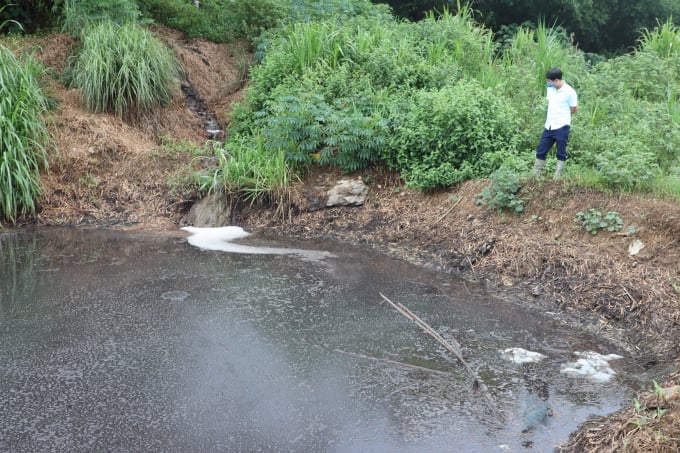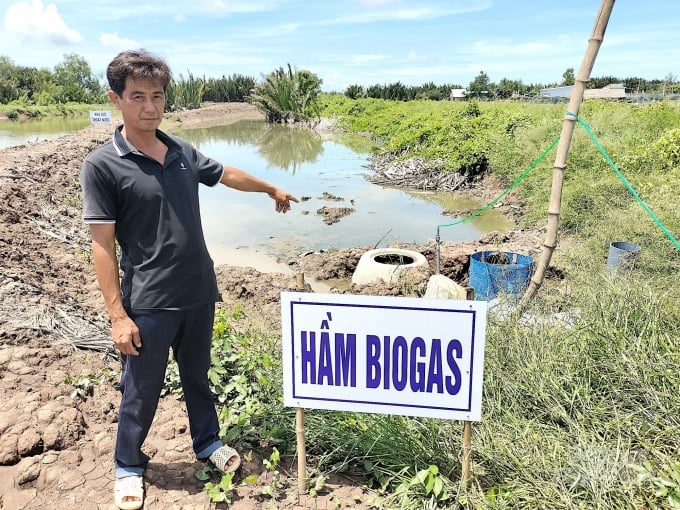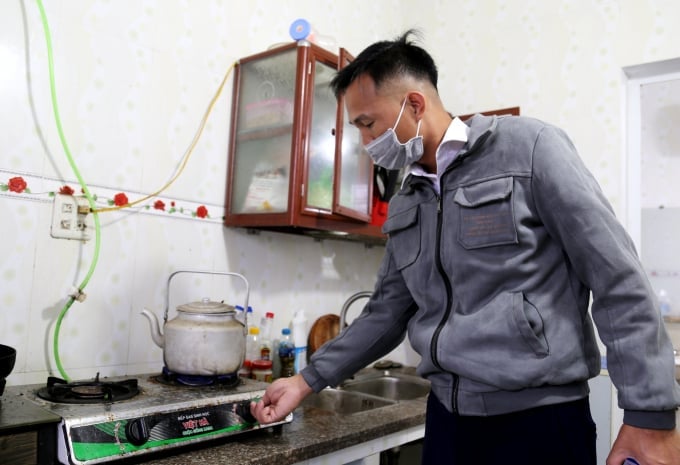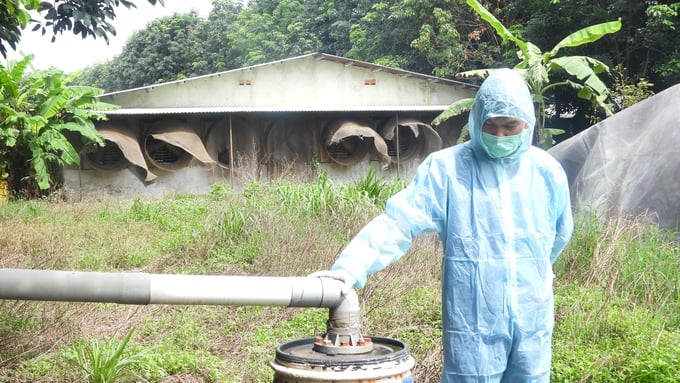May 17, 2025 | 08:22 GMT +7
May 17, 2025 | 08:22 GMT +7
Hotline: 0913.378.918
May 17, 2025 | 08:22 GMT +7
Hotline: 0913.378.918
Vietnam's pig population has consistently remained at around 28 million heads within the last few years, excluding the African swine fever outbreak in 2019. If each pig excretes 2.5 kilograms of solid waste and 5 liters of urine on a daily average, Vietnam generates approximately 25.6 million tons of solid waste and 51.1 billion liters of pig urine annually.
However, the quantity of solid and liquid waste produced by pig farming varies depending on the different methods used for breeding sows and pigs. Breeding sows, which do not require high volumes of water, typically produce solid waste. On the other hand, most pork farms and households use a significant amount of water.

Waste management in pig farming has long been a pressing issue without a comprehensive and effective solution.
According to a survey conducted by the LCASP project in 2019, Vietnamese pig farmers use an average of 30 to 40 liters of water per pig per day for cooling and maintaining hygiene in their pens. Excessive water usage in pork farming results in the majority of pig waste being diluted into liquid waste. Assuming a common distribution of 10% for breeding sows and 90% for meat pigs, Vietnam releases nearly 2.6 million tons of solid waste and 367.9 million cubic meters of liquid waste into the environment each year.
The primary waste generated in the pig farming process which can be treated for reuse is pig manure. Due to Vietnam's demand for organic fertilizers in agriculture, most solid pig manure is collected and used for crop production.
According to aforementioned statistics, only 2.6 million tons of solid waste are collected and primarily used for crop production. However, the methods of utilizing pig manure as fertilizer in many regions carry environmental pollution risks and the potential for disease transmission. Accordingly, these issues arise when farmers apply the manure directly to crops without proper composting, or when they store fresh manure in bags under fruit trees for fertilization. Farmers in the northern regions, namely the Red River Delta, tend to compost manure before application, whereas farmers in the southern and mountainous regions often apply it directly to crops.
Due to the sheer volume of water used in pork farming, approximately 23 million tons of pig manure and urine, become diluted in pen drainage water. Although most farms and households have implemented various methods to treat liquid waste, the most common solution is the use of biogas pits. However, large-capacity biogas pits in Vietnam have not proven to be highly effective in addressing environmental issues in pork farming for a variety of reasons.

Biogas pits often do not provide efficient waste treatment in pig farming.
For small-scale household pig farming, the liquid waste collected after cleaning the pens is discharged into small biogas pits, which are usually under 50 cubic meters in capacity. The biogas generated from these small pits is mainly used for cooking, heating, and other daily purposes. Wastewater from the biogas pits is used for irrigation or directly discharged into the environment.
Overall, the use of small-capacity biogas pits by small-scale pig farmers contributes positively to environmental treatment, albeit inefficient. Small-scale biogas pits cannot fully treat the pig farming environment because the pits have fixed capacity after installation, whereas the scale of pig farming frequently changes based on market conditions and the farmers' needs.
Most small-scale farming households install biogas pits with capacities ranging from 9 to 12 cubic meters. This capacity is sufficient to provide cooking gas for a household of four to six people. Because each cubic meter of biogas pit capacity can only process the waste of one pig, the biogas pit becomes overloaded when households increase their farming scale beyond 12 pigs. Consequently, the resulting wastewater from the biogas pits fail to meet the requirements for discharge into the environment.
Due to the fact that small-scale pig pens are often situated close to residential areas, water usage for irrigation in crop production is low. Only a portion of the water is used for irrigation, and the majority of the wastewater from biogas pits is discharged into the public drainage system of the residential area or into shared water sources, causing severe pollution for the nearby community. This has been an ongoing environmental pollution issue in small-scale pig farming communities for many years. So far, no comprehensive technological solution has been implemented to address it.

Biogas generated from large-capacity biogas pits is often under-utilized.
However, rural small-scale pig farming has been on a rapid decline within the last few years. A number of local governments have implemented strict policies and measures to prohibit pig farming in residential areas. As a result, small-scale pig farming within residential communities will gradually diminish.
Regarding large-scale pig farming, liquid waste is typically discharged into large biogas pits with capacities ranging from hundreds to thousands of cubic meters. Most notably, farmers have installed biogas pits with capacities in the tens of thousands of cubic meters. The majority of large-capacity biogas pits utilize covering technology. The biogas produced by these large biogas pits is often under-utilized for heating purposes such as cooking, burning waste, providing warmth, etc. Many pig farms have previously employed biogas generators; nevertheless, the majority utilized them for a brief duration before discontinuing their usage. A survey conducted by the LCASP Project between 2017 and 2020 found that most pig farms stopped utilizing biogas generators due to a lack of economic benefits.
Most biogas projects, including biogas pits, sedimentation tanks, filtration tanks, and environmental tanks, cannot effectively treat livestock wastewater to meet the current regulations. Consequently, pig farms can be heavily penalized during inspections.
Due to the lack of economic benefits from biogas pits as well as penalties for environmental issues, farm owners often neglect operating, maintaining, and repairing biogas facilities. As a result, many biogas facilities are primarily installed for compliance purposes instead of delivering the desired environmental treatment benefits.

Most large-scale pig farms fail to fully utilize the generated biogas.
Non-compliant waste discharge causing environmental pollution is a prevalent issue on numerous pig farms. This is a challenge that warrants attention in the context of rapid development and gradual replacement of small-scale pig farming in Vietnam.
Pig farms in many developed countries around the world commonly employ minimal water usage to minimize the generation of liquid waste. For example, pig farms in Denmark refrain from using water for pig bathing and pen cleaning during the entire rearing period. Pigs are raised on slatted floors with openings to allow manure and urine to fall into storage tanks located beneath the floor. Liquid waste, comprising urine and liquid manure, is transported by tanker trucks to be used as fertilizer for crops.
Specific regulations apply to the use of liquid waste as fertilizer, including restrictions on waste transport from farms with diseases, allowances for solely forestry and industrial crops, prohibitions on fertilizing vegetable crops for human consumption, and mandatory quarantine periods when used on pastures for livestock grazing. The use of liquid manure injection equipment into the soil is encouraged to reduce odor pollution.

Waste management in pork farming remains a challenging issue.
Due to the minimal water usage in pig farms in developed countries around the world, they cannot fully prevent odors in the rearing process, particularly when utilizing water-saving farming technologies. However, thanks to well-ventilated pen designs, harmful gaseous waste generated by pig farms is quickly dispersed, which causes less harm to human and livestock health. Multiple pig and cattle farms in Denmark, Austria, and other developed countries produce a significantly stronger farm odor compared to those in Vietnam. However, the majority of the odor comes from the animals, which is less detrimental to human health.
Farms in Germany and Austria process liquid livestock waste effectively through biogas digesters, and the resulting biogas is used for electricity generation, providing substantial economic benefits to farm owners. This economic incentive motivates farm owners to operate biogas systems efficiently. The waste generated after biogas processing is also utilized as organic fertilizer for crops.
Many developed countries encourage the treatment of livestock waste to produce fertilizer. Several European countries and Japan requires animal manure to be thermally treated or composted to eliminate pathogens before utilization as fertilizer for crops. Many farms in Europe are equipped with manure separator machines to separate solid waste from liquid manure. The solid waste after separation is used as organic fertilizer, providing a significant source of income for farm owners.
(to be continued)
Translated by Nguyen Hai Long

(VAN) Cold-barn systems efficiently manage environmental and temperature conditions, which aids in the prevention of respiratory diseases in pigs and protects them from the vectors that transmit African swine fevers.

(VAN) To tackle challenges, the project 'Addressing key technical bottlenecks in the grouper supply chain in Vietnam' has been underway since 2024.

(VAN) The project 'Disease-Resilient and Sustainable Cassava Production Systems in the Mekong Region', funded by the Australian Center for International Agricultural Research (ACIAR), is being implemented from 2024 to 2028.

(VAN) Data from 10,000 farming households will help professionalize production organization and support the implementation of the One Million Hectares Program for High-Quality, Low-Emission Rice Cultivation.

(VAN) FAO Director-General QU Dongyu marks International Day of Plant Health at NENA conference.

(VAN) Deputy Minister of Agriculture and Environment Hoang Trung affirmed that floriculture and ornamental plants are a growing industry that receives significant global attention.

(VAN) The three staple crops dominating modern diets – corn, rice and wheat – are familiar to Americans. However, fourth place is held by a dark horse: cassava.